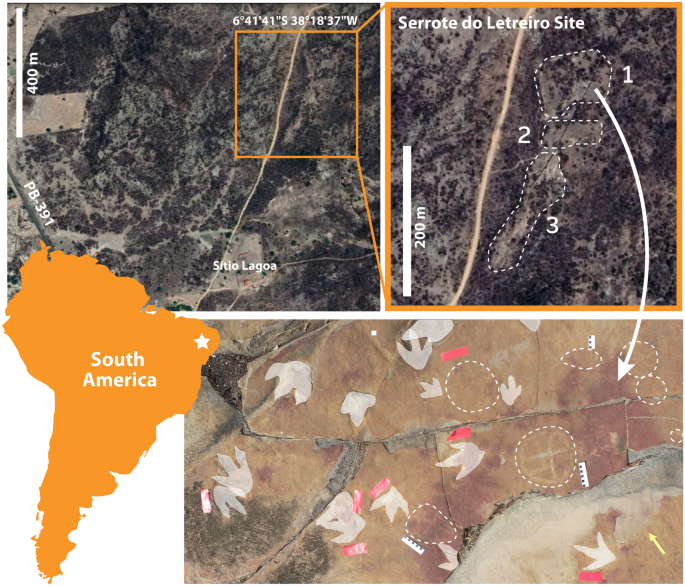Latin America
Related: About this forumA remarkable assemblage of petroglyphs and dinosaur footprints in Northeast Brazil
Published: 19 March 2024
Leonardo P. Troiano, Heloísa B. dos Santos, Tito Aureliano & Aline M. Ghilardi
Scientific Reports volume 14, Article number: 6528 (2024)
Abstract
The Serrote do Letreiro Site, found on the northwest periphery of the Sousa Basin, Brazil, presents a remarkable convergence of paleontological and archaeological elements. It is constituted of sub-horizontal "lajeiros", or rock outcrops, intermingled with endemic Caatinga vegetation. The three prominent outcrops feature fossilized footprints of theropod, sauropod, and iguanodontian dinosaurs from the Early Cretaceous Period. Adjacent to these dinosaur tracks, indigenous petroglyphs adorn the surface. The petroglyphs, mainly characterized by circular motifs, maintain a striking resemblance to other petroglyphs found in the states of Paraíba and Rio Grande do Norte. This study primarily endeavors to delineate the site's major characteristics while concentrating on the relationship between the dinosaur footprints and the petroglyphs. It concurrently assesses the preservation status of this invaluable record, shedding light on its implications for the realms of paleontology, archaeology, and cultural heritage studies.
Introduction
The “Serrote do Letreiro” Site, tentatively translated here as “Signpost Hill”, is located in the Sousa municipality, Paraíba State, Brazil, and is characterized by an outstanding juxtaposition of paleontological and archaeological elements (Fig. 2). The site comprises three large rock outcrops, totaling more than 15,000 square meters in size. The geological context is attributed to the Antenor Navarro Formation (Sousa Basin), Berriasian-Hauterivian in age (Early Cretaceous), predominantly consisting of conglomerate sandstone, characteristic of an alluvial fan paleoenvironment. Within the paleontological interest, the site presents footprints of theropod, sauropod, and ornithopod dinosaurs1. Of archaeological interest are numerous low-relief petroglyphs mainly consisting of circles filled with radial lines and other motifs of deferred recognition, meaning, not easily recognizable, tending to be considered geometric (see Magalhães2, p.195).
The site is located 11 kilometers from the urban center of Sousa Municipality, in the Sertão Paraibano region, State of Paraíba, Northeast Brazil. It is situated in the rural property Sítio Lagoa, accessible via Highway PB-391 (Fig. 1). The site is within the broader context of the Vale dos Dinossauros Natural Monument (Known as Dinosaur Valley), an important natural site located in the Sousa Basin, characterized by the presence of numerous ichnofossils, all dating back to the Early Cretaceous Period3. Access to Serrote do Letreiro is via a dirt road, but direct access involves overcoming obstacles presented by the local xerophilic Caatinga vegetation and barbed-wire fences, installed to prevent cattle from passing through. The climate conditions prevailing at the site are consistent with the typical markers of the northeastern semi-arid region, defined by intense insolation, temperatures reaching values close to 40°C, and prolonged periods of rainfall scarcity.

Location of the “Serrote do Letreiro” Site and central area of the first and northernmost outcrop, with a high concentration of footprints and petroglyphs. (1) Outcrop one, also referred to as Northermost outcrop; (2) Outcrop two, also referred to as middle/central outcrop; (3) Outcrop three, also referred to as Southernmost outcrop. Footprints in highlight and petroglyphs circled by dashed lines. Coordinates are given in the WGS 84 datum. Satellite photography from Google Earth version 7.3 © Google, Airbus, Maxar Technologies. Map generated with Adobe Illustrator 2019.
The first mentions of dinosaur footprints from the Sousa region date back to the early 20th century. However, the paleontological record only became subject to scientific investigation with Giuseppe Leonardi, who began research in the area in 1975, and is credited with the formal discovery of several paleontological sites, including Serrote do Letreiro, found during the 1979 expedition (see pages 102–107 in Leonardi and Carvalho3). Leonardi's research concentrated on the paleontological aspects of the site. Regardless, as early as the 1979 publication, the author mentioned the existence of petroglyphs, and referred to them only as "Cariri Indian carvings." Brief mentions reappeared in the years 20014 and 2002, via a volume published by the National Department of Mineral Production (DNPM, now the National Mining Agency). In 2020, the site was listed on the "Geossit" platform of the Geological Survey of Brazil, which registers national geosites. Additionally, the site is classified on the platform as one of international interest due to the unique intersection between archaeological and paleontological components present there. The site was most recently described by Leonardi and Carvalho in 20211, who again focused on its paleontological aspects.
More:
https://www.nature.com/articles/s41598-024-56479-3
🦕🦖👣